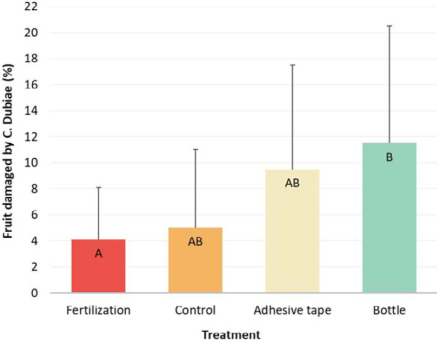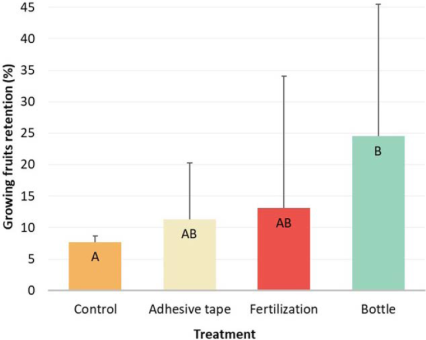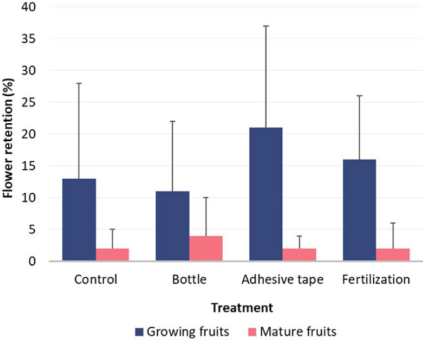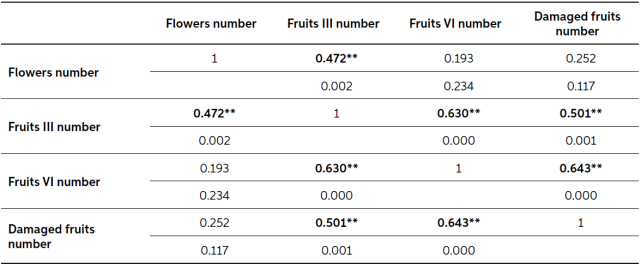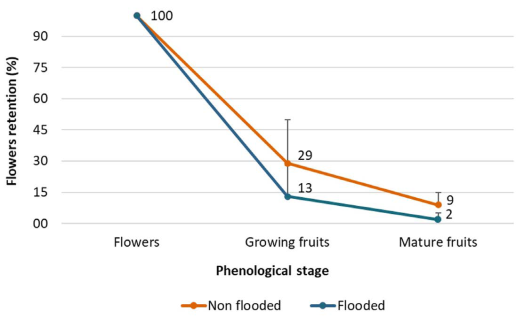INTRODUCCIÓN
Camu-camu [Myrciaria dubia H. B. K. (Mc Vaugh)] is a shrub native to the Amazon basin, adapted to flooding. Fruits produced in Agroforestry Systems are economically important due to their high vitamin C content, and are considered a superfood (Pinedo et al., 2010). The amount of product and the length of the production period depend on agricultural management, e.g. the removal of leaves, called “defoliation”. This practice is widely promoted by experts because it allows profit to be increased through the production of out-of-season fruits and the concentration of the harvesting period, which implies less work for farmers (Imán & Melchor, 2011; Abanto et al., 2014; Paredes et al., 2017).
However, recent trials showed that in flooded systems, defoliation results in a decrease in production, due to the increase in fruit drop (Dávila, 2013; Bardales et al., 2016; Paredes et al., 2017; Pinedo et al., 2018). Pests and nutritional deficits are believed to be the cause of such events. The key pest of camu-camu is Conotrachelus dubiae O'Brien, a Curculionidae that damages the fruits by developing its larvae inside them, causing a loss of up to 80% of the total yield (Farro et al., 2011).
Recent studies indicate that using traps with adhesive tapes (impregnated with entomological glue) is effective for the ethological control of C. dubiae (Pinedo et al., 2017b). However, it is necessary to expand this knowledge by adding to specific agricultural management the ethological control, such as the application of foliar fertilization, to respond to the early fall of the fruits cause by the effects of induced defoliation.
The objective of this work was to find the factors that influence fruit retention in defoliated camu-camu plants by the application of Integrated Pest Management (IPM) techniques, such as ethological control (use of traps) and cultural control (foliar fertilization) in the flooded area. By knowing the nature and understanding the interrelationship of these factors, it will be possible to find the best way to increase fruit retention, therefore improving production.
MATERIALS AND METHOD
STUDY AREA
The research took place between November 2017 and July 2018 at the Experimental Centre “San Miguel” (CESM) of the Instituto de Investigaciones de la Amazonia Peruana (IIAP); an additional control treatment was established at the “El Dorado”, Experimental Centre of the Instituto Nacional de Innovación Agraria (INIA) (Figure 1).
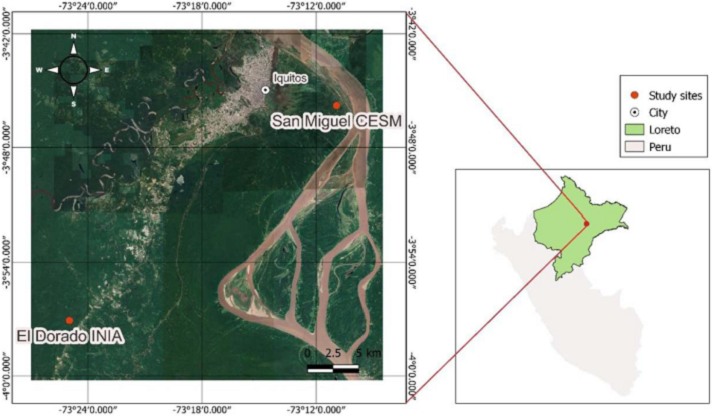
Figure 1 Location of the study area: Experimental Centre "San Miguel" (CESM), near the river, and Experimental Centre "El Dorado" (INIA).
The CESM plot is located 10 km from Iquitos, Loreto, Peru, on the left riverbank of the Amazon River (03°45'48.2" S - 073°10'58.3" W), and characterized by yearly floods. The soil has a silty clay loam texture, and medium fertility; pH 5.88, 1.93% organic material, phosphorus (P) 15.51 ppm, and potassium (K) 279 ppm (Gardini, 2017).
Control plants in INIA site (03°57'04.1" S - 073°24'58.4" W) are not affected by yearly floods. Here, the soil has a sandy loam texture, pH 4.10, a low level of organic material (1.62%), and low concentrations of P and K (3.01 ppm and 58 ppm, respectively) (Gutierrez, 2011).
The eco-climatic conditions at both sites are typical of tropical rainforests: 80% mean relative humidity, and 26 °C mean temperature. The annual rainfall is 2,911.7 mm/year (Pinedo et al., 2017a; Rodríguez et al., 1992).
EXPERIMENTAL DESIGN
In November 2017, 18 thirteen-year-old camu- camu plants at the CESM site (flooded area), which came from natural populations, were defoliated. After flowering (21st March), 40 branches from the defoliated plants were selected. The selection was based on size uniformity and a minimum number of flowers (i.e. 200). The experimental unit used was the branch. Four treatments were applied, with 10 replicates for each treatment. Furthermore, 15 branches of 5 plants at the INIA site (non-flooded area) were assessed. These branches were used as a control to verify the correspondence of phenology and production level to the conditions observed in the flooded area.
TREATMENT DESCRIPTION
The four treatments were applied to 10 branches, which were randomly selected from a total of 40 branches. Control treatment (T1) consisted in the defoliation of M. dubia branches; this treatment was also the only one applied at the INIA plot. A bottle with a yellow sheet (to attract insects) was attached to each of the 10 branches used for treatment 2 (T2). These bottles were filled with water plus detergent (Trome®) to trap C. dubiae. The solution was changed every two weeks, when the presence of C. dubiae was monitored. Treatment 3 (T3) was an adhesive tape impregnated with an entomological glue and a repellent (Campeón®). The adhesive tape was wrapped around the lower part of the selected branches. Both methods were tested and evaluated previously by Pinedo et al. (2017b). Treatment 4 (T4) consisted of foliar fertilization NPK 1-1-1 (Original Extrafollaje by TODO AGRICOLA S.A.®). An amount of 6.25 g l-1 was diluted with 2 l of water per plant and 1 ml l-1 of adjuvant (UltraPegasol by FARMAGRO S.A.®). The solution was applied three times starting at flower blooming, with an interval of three weeks.
DATA COLLECTION
The following data were collected: flower retention (ratio of the number of both growing and mature fruits vs. the total amount of flowers); fruit retention (ratio of mature fruits vs. the number of growing fruits); fruit quality and monitoring of C. dubiae. Fruit retention was recorded by counting the number of flowers (stage I-II), growing fruits (stage III-IV), mature fruits (stage V-VI), including healthy fruits and fruits damaged by C. dubiae (stages follow Inga et al., 2001).
DATA ANALYSIS
The statistical analysis was made with SPSS® Statistics version 20 and Infostat® version 2017. A Duncan’s Multiple Range Test (α = 0.05, Mean square error = 0.005) was carried out for most variables. Mean values of flower retention were calculated. In this analysis, flower retention stood for the percentage of flowers that were able to: 1) develop until fruit stage III and, 2) achieve maturity (stage VI). To deduce the critical period for flower/fruit retention, a correlation between the number of flowers, growing fruits, mature fruits and damaged fruits was computed using the Pearson Model (Sig. < 0.01). Ten branches of T1 from CESM were compared with 10 of 15 branches from INIA (randomly selected). Even if the plants presented differences in eco-climate conditions, provenience and cultivation technique, the comparison is useful to identify the critical points that led to no satisfactory production in the CESM area.
RESULTS
The experimental plants did not produce a great yield. In fact, the total number of harvestable fruits was 398. However, most of them (361) were distributed on 8 of the 40 branches under investigation.
PEST DAMAGE
The mean separation test for the percentage of damaged fruits (stage III) resulted in two subsets: the most effective treatment was T4 (mean = 4.1% ± 4% SD) and the least effective was T2 (mean = 11.5% ± 9% SD; Figure 2). T1 (mean = 5.00 ± 5% SD) and T3 (mean = 9.50 ± 8% SD) did not present significant differences.
FRUIT RETENTION
The percentage of fruits retained from stage III to stage VI resulted in two subsets (Duncan’s MRT, alpha = 0.05): the lower subset represented by T1 (mean = 7.70% ± 1% SD), and the higher subset being T2 (mean = 24.5% ± 21% SD; Figure 3). Treatments T3 (11.30% ± 9% SD) and T4 (13.10% ± 21% SD) did not present significant differences.
FLOWER RETENTION
Figure 4 shows the percentage of flower retention. The analysis did not result in a statistical difference. The highest level of flowers retained until growing fruit (stage III) was found in T3 (21% ± 16 SD). In the case of flowers retained until fruit maturity (stage VI) the highest values were recorded in T2 (4% ± 6 SD); all the other treatments recorded a mean value of 2%.
CRITICAL PERIOD
Table 1 shows a positive correlation between fruits at stage III and the number of flowers (r = 0.472), the number of fruits at stage VI (r = 0.630), and the number of damaged fruits (r = 0.501).
FRUIT RETENTION RELATED TO THE SITE
In INIA, the estimated theoretical production obtained was 48,400 kg ha-1 (calculated from 495 fruits harvested).
Comparison of the retention percentages related to site difference resulted in higher retention values for the INIA site (Figure 5).
PEST DAMAGE RELATED TO THE SITE
T test showed a difference in percentage of damaged fruits between the CESM and INIA sites (p = 0.0168). At INIA the mean was 11% ± 6 SD of the total number of fruits stage VI; this was lower than the value scored at CESM (57% ± 48 SD).
FRUIT QUALITY RELATED TO THE SITE
No statistical difference in fruit weight between the INIA (8.1 g ± 2.19 SD) and CESM (8.4 g ± 1.94 SD) sites was detected by the T test. Ascorbic acid was measured as it is the most significant component of quality for camu-camu. The mean ascorbic acid of fruits at CESM was 2,154.42 mg per 100 g ± 737.98 SD; similarly, at INIA it was 2,517.06 mg per 100 g ± 563.22 SD, with no statistical difference between the two.
DISCUSSION
The lack of satisfactory yield demonstrated the failure of defoliation as a positive cultural practice in flooded areas. Several authors have reported a lack of satisfactory yields using the defoliation technique in flooded areas (Bardales et al., 2016; Davila, 2013; Paredes et al., 2017; Pinedo et al., 2018). Indeed, these crucial circumstances stemmed out the need for this research.
The results regarding pest damage (Figure 2) illustrate that bottle traps were the least effective pest control method, producing more damage than benefits. In fact, fertilized plants had lower losses, due to the increased vigour of the plants (Martinez et al., 2008). Twenty-three C. dubiae adults were found in the bottle traps during the monitoring routine. This data demonstrates that the pest was definitely present in the field, even though it was not possible to achieve a good control with any of the integrated methods; notwithstanding that Pinedo et al., (2017b) reported a high effectiveness of the adhesive.
However, it is clear that the pest is not the single factor influencing production yields; Paredes et al. (2017) listed other factors, such as plant spacing, genetics, plant age, and flooding level during the previous years. Concerning the age of the plant, Pinedo et al. (2010) estimated yields related to camu-camu age in a plantation with a spacing of 3 x 3 m. The regression model for yield vs years shows an exponential tendency. On the other hand, high levels of flooding directly entail more sediments, thus more soil fertility, and consequently higher production (Hiraoka, 1995; Kvist & Nebel, 2001; Pinedo et al., 2011b). However, this research did not record any positive influence of flooding on fruit production; on the contrary, it resulted in a factor of plant stress, dramatically influencing fruit drop.
By relating these results to the fruit retention values (Figure 3), it can be assumed that damaged fruits on T2 did not fall. Consequently, it can be hypothesized that factors other than pest damage influenced the fruit drop for T2. In previous studies, 90.7% of drop cases were attributed to physiological abortion of flowers, fruits, or both. Other studies attribute fruit drop to genetic characters, environmental factors (such as wind, temperature, and rain), hormonal and metabolites concentrations, including boron (Agustí et al., 2003; Chavez, 2017; Farro et al., 2011).
All these factors are not controlled by applying the two IPM control treatments. In the case of T1, it can be assumed that the low retention could be partly caused by C. dubiae damage. In other words, control treatment (T1) showed similar damage as the bottle trap (T2), but it could not retain as many flowers, fruits or both as the traps did. As a matter of fact, when compared to bottle traps, the control treatment did not show statistical differences in the level of damage, but it did show differences in fruit retention.
Regarding flower retention (Figure 4) no statistical difference was observed between treatments. However, the results are below the approved threshold, estimated at 25% of flowers that develop into fruits, and 4 to 12% achieving fruit maturity (Farro et al., 2011; Imán, 2000; Pinedo et al., 2018). Although low fruit retention is a natural physiological phenomenon that allows the plant to maintain the correct number of fruits in relation to the nutritional status (Pinedo et al., 2018; Stephenson, 1981), in this case, low retention underlined an uncommon fruit production, attributable to the presence of flooding during the critical period of fruit development.
The correlation between fruit in stage III and the number of flowers, the number of fruit in stage VI and the number of damaged fruits (Table 1) demonstrated that a higher number of fruits means a higher number of damaged fruits. Moreover, the number of growing fruits (stage III) depends directly on the number of flowers, but there is no correlation between the number of flowers and the number of mature fruits (stage VI). This lack of correlation is evidence that the critical stage for retention occurs after the formation of fruits. This critical period corresponds mainly to stages III and IV of fruiting, that is, 26 to 43 days after flower opening (Pinedo et al., 2001).
The yield value for the INIA field was even higher than the threshold of 39,9 ton/ha estimated by Pinedo et al. (2010) with no defoliation. In this research, the application of defoliation is one of the reasons for the theoretically calculated higher yield value. However, the projection is based on approximate data that showed discrepancy with the actual situation, but it shows that, in contrast to the CESM results, at INIA the branches could produce a good amount of fruits. Likewise, previous trials reported good yield after defoliation (Abanto et al., 2014; Imán & Melchor, 2011; Pinedo et al., 2011). However, only in the investigations of Abanto et al. (2014) and Imán & Melchor (2011), was there an absence of flooding. In fact, site position seems to be a key factor for the success of harvesting. The factors for the INIA estimated yield success was not only the defoliation technique, but also the absence of stress caused by flooding events.
It is not a surprise that fruit retention at the INIA site (Figure 5) was above the threshold, estimated at 25.35% of flowers retained until growing fruit, and 5.1% until maturity (Farro et al., 2011). In contrast, the CESM plants could not provide the required nutritional elements to the fruit, while the metabolism is slowed down by the flooding.
There was no statistical difference in retention for growing fruits, only for mature fruits, meaning that the critical period for retention is after the fruit has initiated its development.
The higher percentage of damaged fruits at the flooded site contrasts with the common understanding that pests are better controlled by unfavourable conditions such as flooding (Perez & Iannacone, 2008; Pinedo et al., 2015). However, C. dubiae tend to resist flooding events due to the species phenotypical plasticity (Delgado et al., 2014). Even if camu-camu is naturally adapted to flooding (Peters & Vásquez, 1987), under natural conditions fructification never occurs when the river water level is high. It is true that plants at the INIA field are managed annually (pruning, weed control, cover crop management and fertilization). These operations may cause better sanitary conditions at the plot and therefore allow plants to better resist pest damage. Moreover, the plot in the INIA area is located far from the forest and therefore the pest source.
According to previous studies, harvested fruit weight (INIA 8.1 g ± 2.19 SD; CESM 8.4 g ± 1.94 SD) was consistent with the range reported: 2 to 20 g (Osorio et al. 2001), 8.4 g (Pinedo et al. 2001) and 7.5 to 8.3 g (obtained with ferti-irrigation by Abanto, 2010). On the contrary, values were not in the range established by Imán & Melchor (2007) (9 to 13 g). However, Imán & Melchor (2011) differentiated fruits into two groups: big fruits, weighing 11.47 g, and small fruits weighing 5.79 g on average. Values in this research were still lower than the ones cited in Chavez (2017), obtained after boron fertilization (up to 11.1 g). The same applies to fruit weights stated by Farro et al. (2011) for plants originating in the Putumayo River basin (10.89 g) and the ones measured by Pinedo et al. (2011) (8.61 to 8.84 g).
Ascorbic acid values recorded in literature ranged between 725 and 3,000 mg per 100 g of pulp (Pinedo et al., 2010). At CESM, even though the plants were under stress, the fruits were of good quality, with high ascorbic acid content (2,154.42 mg per 100 g ± 737.98 SD). No influence of defoliation had an impact on other fruit quality features, as the weight of the fruits, the Brix content and the ascorbic acid level showed similar values both at CESM and at INIA. Also, a correspondence to the values reported in literature for non-defoliated trials was found. No difference in fruit phenology was reported between CESM and INIA. The two initial weeks of difference in defoliation was maintained during the fruiting period.
Further investigation is recommended of the most important factors connected to fruit retention in the critical phase (from stage III to maturity), that caused the defoliation failure, such as the flooding level during fructification and the nutritional status of plants. Furthermore, establishing an IPM threshold will definitely help to achieve better pest management. It is therefore recommended to study the biology and behaviour of the pest in more detail.
CONCLUSIONS
The main factor causing fruit drop in camu-camu plants was the presence of flooding events. The critical period for fruit retention occurs immediately after the fruit development (stages III and IV of fruiting). Therefore, any intervention carried out to avoid fruit fall must consider the period of fruit development.
The pest control treatments applied did not have a positive impact on the production levels of branches, except for fertilization. The use of bottle traps showed the highest level of fruit damage by insects and the highest level of fruit retention. Consequently, it is possible to state that the primary cause of fruit drop was not the pest. The use of bottle traps is more likely effective for monitoring rather than for control.
Regular fruit production was obtained at the non-flooded site.












 uBio
uBio 
